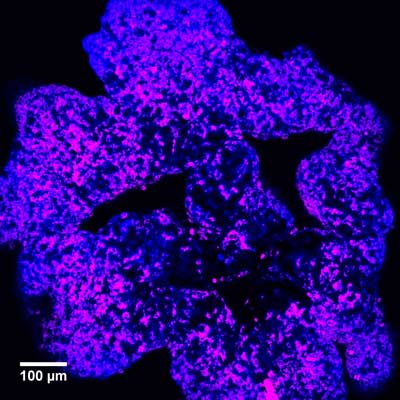| Posted: Nov 25, 2016 |
Using thermal measurement to improve cancer therapy outcomes
(Nanowerk News) Researchers at the Adolphe Merkle Institute (AMI) at the University of Fribourg, along with colleagues from the Zurich University of Applied Sciences (ZHAW), Winterthur, have developed a novel characterization method, NanoLockin, which can help optimize the design of nanoparticles used in a recent form of cancer therapy known as magnetic hyperthermia (Nanoscale, "A lock-in-based method to examine the thermal signatures of magnetic nanoparticles in the liquid, solid and aggregated states").
|
 |
| Model of cancer cells (blue) containing iron oxide nanoparticles (magenta). (Image: Thomas Moore/AMI)
|
|
Magnetic hyperthermia, which relies on iron oxide nanoparticles heated by an alternating magnetic field to kill off tumor cells, has already been authorized in the European Union and implemented notably at Berlin’s famous Charité hospital. Nanoparticles are injected close to the tumor site and then activated by the field. Heat is generated by the particles reacting to the field. If the nanoparticle dosage is right, the tumor is destroyed. Clinical specialists say hyperthermia could be the fourth pillar of cancer treatment, along with surgery, radiotherapy and chemotherapy. However, since the nanoparticle properties are highly dependent on particle and magnetic field properties, optimal dosage remains challenging.
|
|
To improve the likelihood of a positive outcome, the AMI researchers, who are specialized in nanoparticle characterization, wanted a method to visualize the behavior of iron oxide particles when heated by a magnetic coil. Current systems rely on fiber optics plunged into a nanoparticle suspension, but this method is less than reliable and suffers from various disadvantages such as low reproducibility, long measurement times and the risk of biased data treatment. They decided instead to use lock-in thermography imaging technology originally developed for the quality control of aircraft parts.
|
|
Faster and more efficient
|
|
By using the NanoLockin method, production and dosing of those nanoparticles can be optimized.
|
|
“If we want to pursue the development of magnetic hyperthermia, it is extremely important to precisely measure and understand the properties of the nanoparticles you are using,” says AMI NanoLockin project leader Christoph Geers. “With NanoLockin, producers of therapeutic nanoparticles have a tool to easily and precisely control as well as improve their products.”
|
|
When nanoparticles are used for cancer therapy for example, this would mean that the particle concentration is the best possible for its target. This also means the treatment would work faster, more successfully and at lower cost.
|
|
The scientists at AMI led by the BioNanomaterials group co-chair, Professor Alke Fink, together with ZHAW lecturer Dr. Mathias Bonmarin, developed the Nanolockin system which can precisely measure the distribution and the heat generated by the nanoparticles. Other team members are Christophe Monnier, whose Ph.D. thesis was largely focused on the project, and Ph.D. student Federica Crippa.
|
|
The technology developed by the NanoLockin team relies on an alternating magnetic field and infrared imaging to precisely measure the heat produced by the nanoparticles. The results are then evaluated using software specially developed for the system. An algorithm provided by the ZHAW helps specifically determine the nanoparticles’ heating properties based on how they react to the magnetic field. The other advantage of the measurement system is that there is no contact between the measurements device and the sample, meaning nanoparticles can also be observed in a realistic environment such as tissue samples.
|

